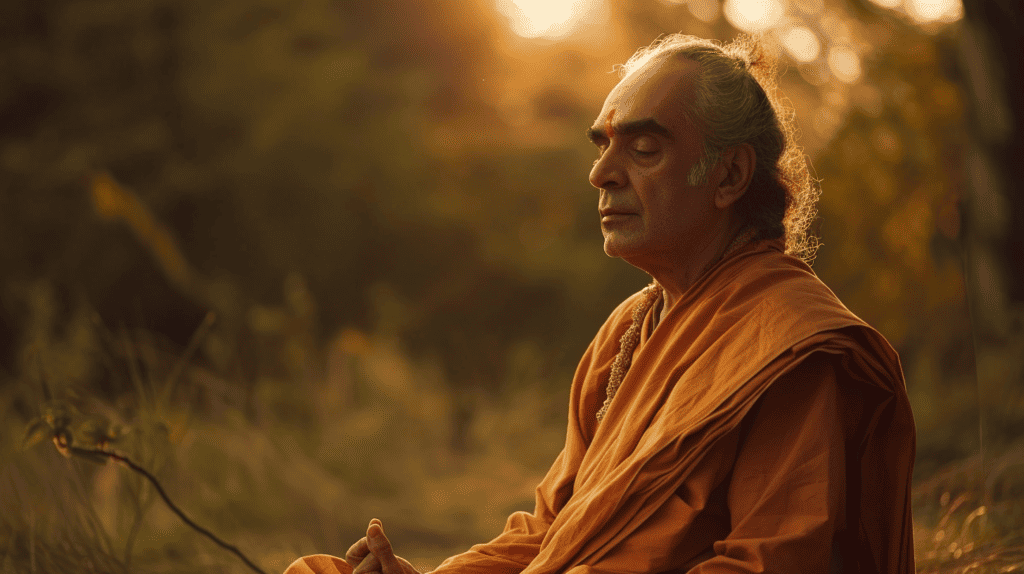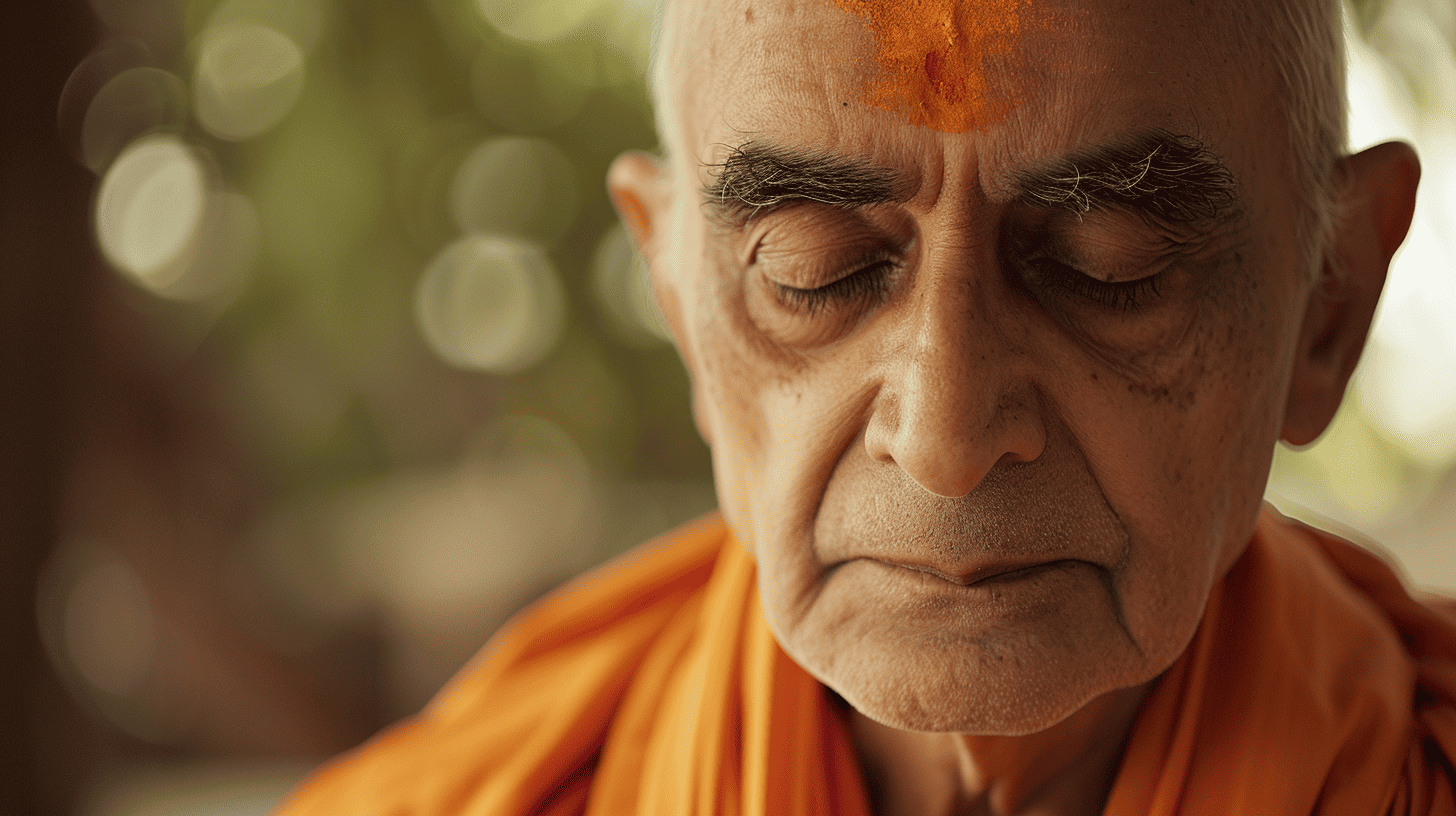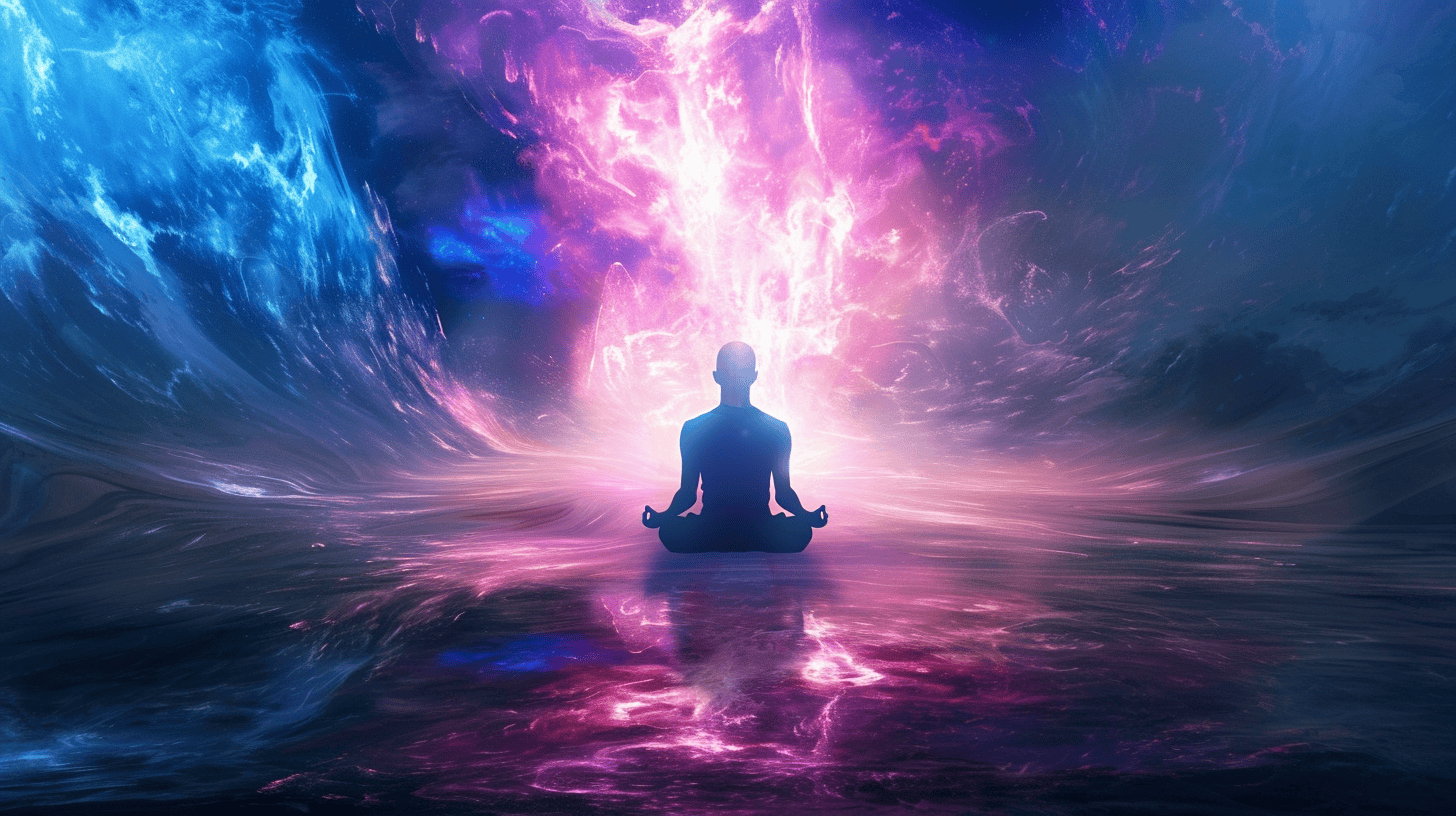I still remember the first time I sat to meditate. I was a graduate student studying psychology in Europe, and one of my professors suggested I read some books by a Himalayan master named Swami Rama. As I dove into Rama’s writings on meditation, yoga, and the inner journey, I felt I had stumbled upon an immense treasure trove of wisdom from India. Though Rama had passed away by then, his teachings were very much alive through the practice of his students worldwide. I was inspired to take up the practice of meditation myself and see what truths I could uncover.
Over the years, I have found Swami Rama’s guided meditation remarkably helpful and effective. In this article, I’d like to share an overview of Rama’s system of meditation—from fundamental principles and key practices to common obstacles and ultimate goals. My aim is to encourage you, the reader, to experiment with meditation and reap its incredible benefits for body, mind, and spirit.
Key Takeways:
- Swami Rama brought ancient yogic meditation methods from India/Himalayas to modern world
- His teachings offer step-by-step practical guidance to steady the mind and expand consciousness through mantra, postures, breathwork
- With regular practice, one gains clarity, equanimity, inner peace.
- By turning attention within through meditation, we can realize divine eternal nature beyond ego.
A Revered Himalayan Master
Here is a table providing some background on Swami Rama and his spiritual lineage:
| Detail | Information |
|---|---|
| Full Name | Brij Kishore Kumar, known as Swami Rama |
| Birth | 1925, Northern India |
| Early Life | Raised by guru Sri Madhavananda Bharati in Himalayan caves and monasteries. Studied with saints, yogis, and spiritual teachers across India. |
| Education | Studied psychology, philosophy, medicine, and more at various Indian universities. Also studied at Oxford University. |
| Spiritual Lineage | Part of the Himalayan yoga tradition passed down from ancient Vedic seers and yogis. His teacher was Sri Bengali Baba. |
| Accomplishments | Became Shankaracharya of Karvirpitham at age 24, later renounced. Founded the Himalayan Institute to bring Eastern teachings West. Prolific writer on yoga and spirituality. |
| Legacy | Over 20 books and many audio teachings conveying the Himalayan yoga tradition to modern audiences. Established centers worldwide through his Himalayan Institute to teach meditation and holistic living. |
| Death | November 13, 1996 |
Swami Rama was born in Northern India in 1925 and, from a young age, was raised and trained by a Himalayan yoga master. He held prestigious spiritual titles and studied extensively, both spiritually and academically. His mission was to share the ancient teachings of the Himalayan yoga tradition with the modern world. Through writings, teachings, and the establishment of the Himalayan Institute, his legacy continues to impact lives worldwide.
Let’s now explore some core components of what he taught.
Swami Rama Step-by-Step Instructions
Before Meditating
- Choose a quiet place where you can meditate without distractions or interruptions.
- Sit comfortably with a straight spine, either cross-legged on the floor or in a chair.
- Relax your body completely, starting from the top of your head down to your toes. Let go of any muscular tension.
- Practice diaphragmatic breathing – breathing slowly, deeply and rhythmically using the diaphragm.
During Meditation
- Close your eyes and withdraw your senses from external distractions.
- Bring your full attention to your mantra, given to you during initiation.
- Repeat the mantra slowly, gently and silently with full feeling and concentration.
- Let go of all thoughts and allow your mind to be led by the mantra.
- If thoughts arise, gently return to mentally repeating only the mantra.
- Follow the sound of the mantra to increasingly subtle levels, leading to the soundless state beyond body and mind.
After Meditating
- Sit for a minute or two allowing the peace and stillness to integrate.
- Ease your attention outward slowly before getting up. Carry the calm state into your next mindful activity.
- Consider journaling insights gained during meditation.
- Reinforce positive ideas or learning from the practice.
The key is regular, dedicated practice over time. Be vigilant yet relaxed. Progress will come through systematic technique and sincere aspiration.
The Practice of Mantra and Meditation
A foundation of Swami Rama’s practical teachings on meditation is using a mantra.
“A mantra is a revealed sound that has a spiritual effect when recited or meditated upon.” (Himalayan Institute, 2022).
Here is a table summarizing some of Swami Rama’s key mantras and their purpose:
Mantra Purpose Om The primordial sound, connects to universal consciousness So Ham “I am That” mantra for self-realization Om Namah Shivaya Salutation and surrender to Divine Consciousness Gayatri Mantra Illumination of the intellect and removal of ignorance Mahamrityunjaya Mantra Victory over the death of ignorance Asato Maa Mantra Leads from untruth to truth, from darkness to light Personal Initiation Mantra Given by a teacher for meditation practice Mantra of Happiness Cultivates an attitude of joy and contentment
The verbal repetition of a mantra while focusing attention is an extremely useful tool to steady the mind, concentrate, and enter tranquil states in meditation. As Rama himself told students:
“I give you a mantra and also teach you its proper technique…with practice this becomes a process of purifying the mind and making it one-pointed so you can know your inner life.”
So the structured practice of mantra serves to cut through mental distractions and “noise” to reveal the crystal clarity of consciousness beneath.
Tip: Experiment with a mantra in your meditation even if for just 5 minutes. Feel it vibrate through your body, let go of other thoughts.
In my own practice over the years, I’ve found integrating a meaningful mantra enormously steadies the mind, uplifts the emotions, and opens inner doors of insight and joy. It becomes an anchor keeping one centered amidst external worries and desires as well as inner turbulence. I encourage you to test this age-old yogic technique for yourself!
Mixing Breath, Posture and Awareness
Beyond mantra, Swami Rama presents a full range of methods in his teachings on meditation:
| Method | Description |
|---|---|
| Breath Meditation | Focuses the mind on the breath to calm thoughts and develop concentration |
| Mindfulness | Brings full awareness to the present moment with an attitude of openness and non-judgement |
| Body Scanning | Systematically moves attention through the body to relax it and develop mindfulness |
| Visualization | Forms mental images, often of inner energy centers or enlightened beings, to focus the mind |
| Sound Meditation | Listens to inner subtle sounds as an object of concentration |
| Contemplation | Reflects deeply on spiritual principles or ideals to integrate wisdom |
| Devotional Meditation | Cultivates love and surrender to the divine through prayer or chanting |
| Open Monitoring | Remains open and observant of anything arising in the field of awareness |
I particularly appreciate how Rama guided students to patiently build a holistic practice integrating many facets like a mantra with mindfulness of breath, body, and thought flow. His step-by-step instructions allow one to construct a complete yet customizable method of meditation carefully. This framework provides the stable foundation to explore more profound yogic techniques for refining and expanding consciousness.
For example, long before mindfulness meditation became popularized, Rama stressed cultivating moment-to-moment nonjudgemental awareness in all activities:
“The purpose of meditation is to make the practitioner calm, quiet, and peaceful within himself. When you are peaceful within you will be able to observe the activities of the mind.” (Himalayan Institute, 2022).
Such grounded, receptive attention to the present lays the bedrock for meditation.
In my journey over decades now, I’ve come back again and again to these simple, potent principles and built my entire practice upon them. Rama ingeniously conveyed traditional yogic wisdom through a systematic, incremental system perfectly suited for the modern student—whether in the foothills of the Himalayas like himself or amidst the rush of daily life in the West.
Navigating Obstacles Along the Way
Another practical component of Swami Rama’s comprehensive meditation framework is anticipating and overcoming obstacles:
- Dealing with physical discomfort
- Working with emotional blocks
- Maintaining motivation
- Balancing effort and surrender
I distinctly recall in my first few weeks attempting to sit silently, the discomfort and restlessness were so intense I questioned if I had the fortitude to continue! Rama recognizes such inner resistance as natural, even helpful for strengthening one’s patience and resolve:
“Do not be discouraged by the difficulties that arise…Without difficulty one cannot make progress.” (Swami Rama, 1976).
This firm yet reassuring guidance gave me courage during those initial challenges. And indeed, over months and years of steady daily practice, the obstacles lessened, inner focus sharpened, and glimmers of tranquil awareness emerged.
The Fruits of Practice: Clarity, Equanimity, Compassion

While most drawn to meditation seek stress relief and health benefits, Rama aims the student much higher—towards tapping inner creative power, profound understanding, and supreme liberation:
“We must seek the highest, not be pulled down by the lower instincts and desires. The purpose of this human birth is to know, ‘Who am I? Where have I come from? Where am I going?’ Question yourself…Read scriptures, associate with those who know…With mirror-like calm reflect within, ‘What am I?’ One day the light of knowledge will dawn.” (Rama, 1976)
This points to meditation as systematic mind training to cut through illusion and instead realize one’s eternal Identity beyond all limitation. Rama firmly guided students to look within for answers, not outside. Peeling away the ego or surface identity naturally unfolds higher perception and being:
- Achieving a still, silent witnessing awareness beyond all thought
- Directly perceiving the cosmos as Divine Expression
- Embodying innate compassion towards all beings
While perhaps only glimpsed momentarily at first, over time these radically expanded states of consciousness became more integrated and perceived as equally “real” in my experience—completely transforming my self-identity and worldview. Truly as Rama promised, through the window of meditation I discovered my essential nature as unbounded Awareness itself. And the practical guidance to realize this was there all along in Rama’s books!
Bringing Timeless Teachings Into the Modern Age
In closing, I remain deeply grateful to Swami Rama for bringing this ancient science of yogic meditation alive in the 20th century…and now into the 21st! By establishing the Himalayan Institute and training other teachers, this knowledge continues spreading worldwide. Rama’s clear, systematic instructions remain extremely relevant and transformative. His masterful communication makes intricate practices understandable and demystifies the inner journey.
I hope this article has provided some inspiration to experiment with meditation yourself. Adapt these universal methods and practices into your own life—I can promise they will bear fruit with patience and sincerity. As Rama reminded:
“I am nobody…I am the Self.”
This simple but profound wisdom remains the beating heart of his meditation teachings. May we discover this inner treasure for ourselves!
FAQ on Swami Rama Guided Meditation
Q: What is the yoga method of meditation by Swami Rama?
A: The yoga method of meditation as taught by Swami Rama involves a guided practice of mantra. This method is detailed in his work “Meditation and Its Practice,” and largely focuses on an inward journey, away from the external world. The end goal is to reach a highest state of consciousness through practicing meditation.
Q: Where can I learn about the Himalayan Institute’s teachings on meditation?
A: The teachings of the Himalayan Institute, including the method of meditation by Swami Rama, are detailed in various books and online resources. One of the most significant resources is “Meditation & Its Practice” by Swami Rama, where the technique of meditation is explained for anyone who wants to know.
Q: What is the importance of ‘external’ and ‘inward’ in Swami Rama’s guided practice of mantra?
A: According to Swami Rama, the process of purifying the mind and making it one-pointed happens when we move our focus from the external world to an inward journey. By controlling and focusing our mind, we can find greater peace and ultimately reach a higher state of being.
Q: What does it mean to have a ‘one-pointed’ mind in meditation?
A: Having a one-pointed mind refers to the process of purifying the mind and making it focused on a single point or thought. The idea here is that a focused mind will help us delve deeper into our inner life, bringing us closer to our true self and the ultimate truth.
Q: I want to know about the basics of Swami Rama’s meditation method. Where do I begin?
A: A great starting point is Swami Rama’s book “Meditation and Its Practice,” where you’ll learn to sit still, focus your mind, and enter a space of tranquil meditation. This book gives a detailed guided practice of mantra and explains the process of purifying the mind and making it one-pointed.
Q: Are there any teachings of Swami Rama outside of India?
A: Yes, the contributions of Swami Rama and the Himalayan tradition have spread globally. His teachings are not only practiced in India but also have a significant following in several parts of Europe and other continents where his guided meditation instructions continue to lead individuals to inner peace.
Q: What role does ‘nobody’ play in the process of meditation according to Swami Rama?
A: When Swami Rama refers to ‘nobody,’ he’s discussing the idea of letting go of one’s self. By becoming ‘nobody’ during meditation, one can disconnect from the external world and fully engage with their inner life and light. This, in turn, brings tranquility and the highest state of consciousness.
Q: Can practicing the method of meditation by Swami Rama bring changes to my life?
A: Absolutely! This method can lead to considerable changes, both within and without. As you learn to orient your mind inward and purify your thoughts, you’ll notice a sense of peace and calmness permeating your daily life. Regular practice can help you reach the highest state of consciousness, influencing how you interact with the world around you.
Q: Who can use Swami Rama’s meditation practices?
A: Nobody is excluded from using Swami Rama’s practices. Whether you’re a beginner or an expert, or regardless of your religious beliefs or age, you can follow Swami Rama’s method of meditation. The guided practice of mantra is designed such that anyone can learn and benefit from it.
Q: How can Swami Rama’s teachings help me in understanding the Himalayan tradition?
A: Swami Rama was a prominent yoga master from the Himalayan tradition. By studying and practicing his guided meditation practices, you are directly engaging with the wisdom and techniques that have been passed down through generations in the Himalayan tradition. This will give you a deep understanding of this ancient tradition’s approach to meditation and spirituality.





Leave a Reply